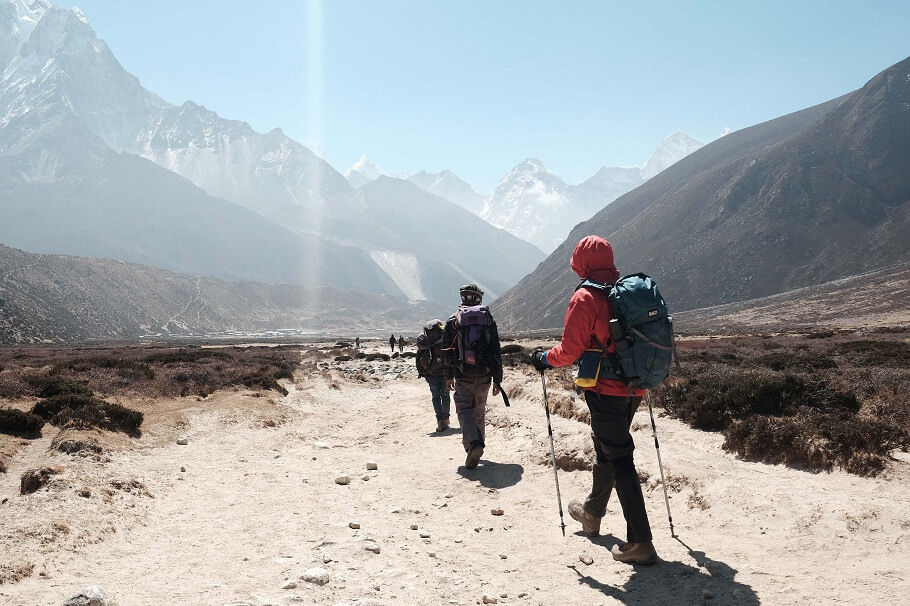A month in the laps of the wonderful Himalayas is perhaps the best way that you can spend your holidays. At the lap of such gorgeous mountain such as Everest, you are bound to have memories of a lifetime. But trekking there can depend upon a variety of things.
Apart from finance, you also have to look at the geography, the best time to trek, your packing and the gradual way that you train yourself to see how difficult the trek to the Everest Base Camp can be.
Yes, trekking to Everest Base Camp will be glorious. But the glory you get comes with how you can get over the hurdles that the Everest Base Camp is likely to throw at you. These are the various things that determine the difficulty of the Everest Base Camp trek.
Table of Content
1. Altitude and Elevation of Everest Base Camp Trek
Coping with the altitude is one of the most difficult things about Everest Base Camp Trek. Don’t get fooled by Sherpas, whom you constantly hear scaling Everest for fun. They have spent their entire lives there.
But if you are a person that lives very close to the sea-level, it might be difficult to adjust to the climatic conditions that you are likely to encounter at the Everest Base Camp. So you need to be extremely careful.
A person who wants to trek to Everest Base Camp can get a flight to Luka, the heart-throbbing airport of the Everest region. Lukla itself is close to 3000 meters. If you are looking forward to going to Lukla, you can spend a few days on the outskirts of Kathmandu to get into the groove of altitude.
As you go along your trekking route, you should take at least a day at each trekking stop to familiarize your body with the climatic conditions there. From Luka, you’ll probably trek to Namche Bazaar, which is located at an altitude of 3500 meters. You should probably spend a night or two there before you can take a trek any further.
As you cross the passes and other scenic locations there, you have to be wary of the vertical distance you climb. You might feel energized to scale as much as you can. This is when your group might come to rescue.
Traveling with a group takes you slower than usual, and the unique perspective of people along with you can help you appreciate trek to Everest Base Camp in ways that you might not have before. Going slow also help in acclimatizing.
When you go to Kalapathar, the height is an astounding 5500 meters. Don’t undermine it. Even Sherpas who have lived there have difficulties coping with the climatic conditions there. And even they suffer from altitude sickness.
So take as much time as you can for acclimatizing. The more time you take, the better your body gets adjusted to the tune of the Everest region.
2. Length of the Everest Base Camp Trek

Apart from the vertical distance you cover, you also have to bear in mind the total length of the trek. Although the vertical distance you cover is just over 2500 meters, the total length of the trek is a formidable 130 kilometers!
You can’t expect to directly hike up the mountain. Just like a car needs to circle around the hill to get to the top, you might also need to take certain detours along the way. Periods of walking down a hill can be followed by periods where you continuously go up the hill.
Even if you walk an average of 10 kilometers a day, you might still need to traverse 15 days. A normal trekker travels about 15 kilometers a day for about 10 weeks.
Walking up a hill can be exhausting. And you need to make sure that you don’t over-exhaust yourself. Over-exhaustion is one of the biggest reasons why some trekkers don’t complete it. And if at any point of time you feel that you can’t take a step back. You can always come back to it.
Don’t take any chances with your body.
But worry not, you walk close to 5 kilometers per hour. This means that a normal three-hour trek a day will be enough for you to trek Everest in 10 days. The difficult topography might mean that the time you normally take would double.
But:
Is that a worry?
Absolutely not!! A six-hour trek is something anyone can undertake with appropriate training.
3. Training of Everest Base Camp
Everest Base Camp is not intended for people who have no trekking experience. Instead, people who have mild trekking experience need to train well to make the cut.
First, you need to carry all your items with yourself. That makes it a bit difficult.
But:
You can take a porter with you in which case your load is well shed.
But if you want to enjoy the trip with your presence alone, you need to start preparing right away. If you have no fitness regime, you can start with a light jog for 15-20 minutes and increase the duration to about an hour.
As you get better, upgrade to running. This will help you develop good thigh muscles. The thigh muscles are of utmost importance as the bulk of the load is in your thighs during the trek.
After you have become a healthy runner, you can run carrying some weight. Start with the lightest pound, say 5 pounds and upgrade to 15 pounds.
Squatting is another way to ‘tighten up your thigh muscles. A gym can come in handy.
Also, you need to do shoulder training as well. Don’t discount the part played by your arms and shoulders to carry you forward. And they also share the load of your backpack. You can start with a few push-ups, playing with punch bags.
So after training for 6-8 weeks, you will be good to go.
If you don’t have a gym subscription, you can get one. Gyms have a great range of equipment and help you in developing specific strength for specific parts of the body.
And if you want to save some money, you might want to check YouTube professionals and their channels.
4. Gearing Up
Many people take into account the length of days that you trek and altitude that you climb. But do you know what is one of the most important things that you need to consider?
Your Gears!
Trekking gear is what makes you carry all the items needed, even in the case of an emergency. It helps your body function smoothly and document your experience there. Let’s take a look at how gear helps with the difficulty of the trek.
One very good way to cure the altitude problem is to hydrate yourself at all times. For this, you need to carry proper water bottles and have a bag that facilitates that. You need to carry all the proper items for your skin. You will require a first aid toolbox.
Good shoes are synonymous with good treks. After all, your shoes facilitate the treks with ease and help distribute your weight evenly across the heel, palms, and toes. Good shoes will also keep away the pressure that is exerted in the legs and keep you willing to walk at all times.
5. Which month are you trekking to Everest Base Camp?

Knowing about the timings of your trek is as important as it can get. Nepal has various seasons and the difficulty level changes along with seasons as the climate might be too hard even for hardcore trekkers.
Summer and monsoon treks should be avoided for safety reasons. At this time of the year, the snow is on the verge of meltdown and having a strong foothold is next to impossible. Besides, slippery snow is often dangerous.
Winters are too hard for reasons of the extreme cold. The temperatures are known to get down to almost -20 degrees. Hypothermia becomes an acute possibility. This time is only advised for professional mountain climbers.
The best months to trek Everest Base Camp because of good climatic conditions and visibility is the autumn and spring season.
Autumn starts in Nepal from the end of September to the end of November. Climate is mild and tolerable.
The same goes for spring, which lasts from late February to May. Just before the onset of difficult mountainous summer, the spring is a wonderful time to consider trekking.
Conclusion
So to the age-old question, “ Is it difficult to trek Everest?” The answer is that you have to take in a variety of factors. But with sufficient training and background check, you must be able to trek to Everest Base Camp despite the scary stories out there.
You have to look at these 5 things. As long as you trek adjusting your body with altitude, your body will support you. Strength training comes in handy. Pack properly, eat and hydrate constantly and choose the easiest season which is available to you.
So throw all your fears away and start your preparation for the dream that is Everest Base Camp Trek!